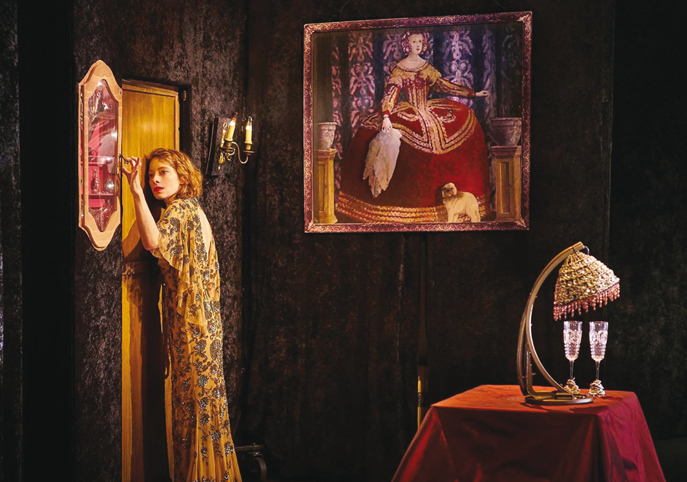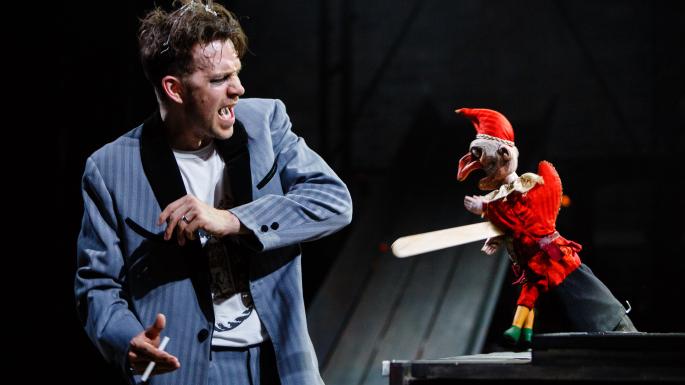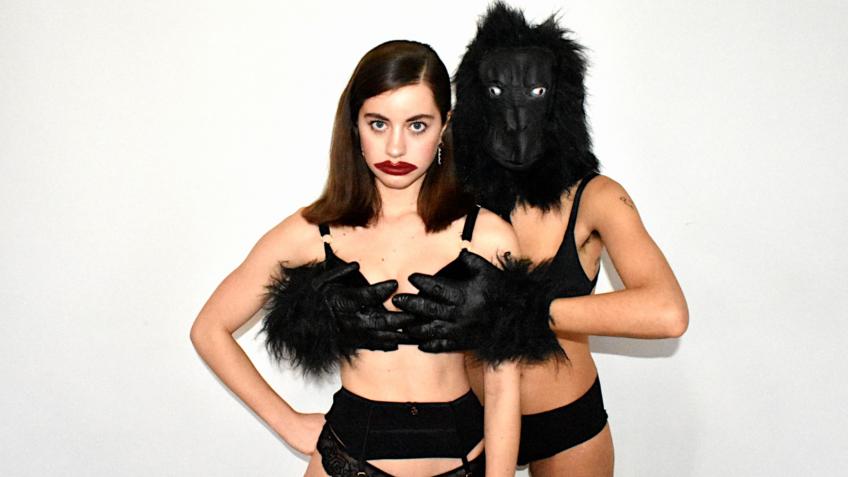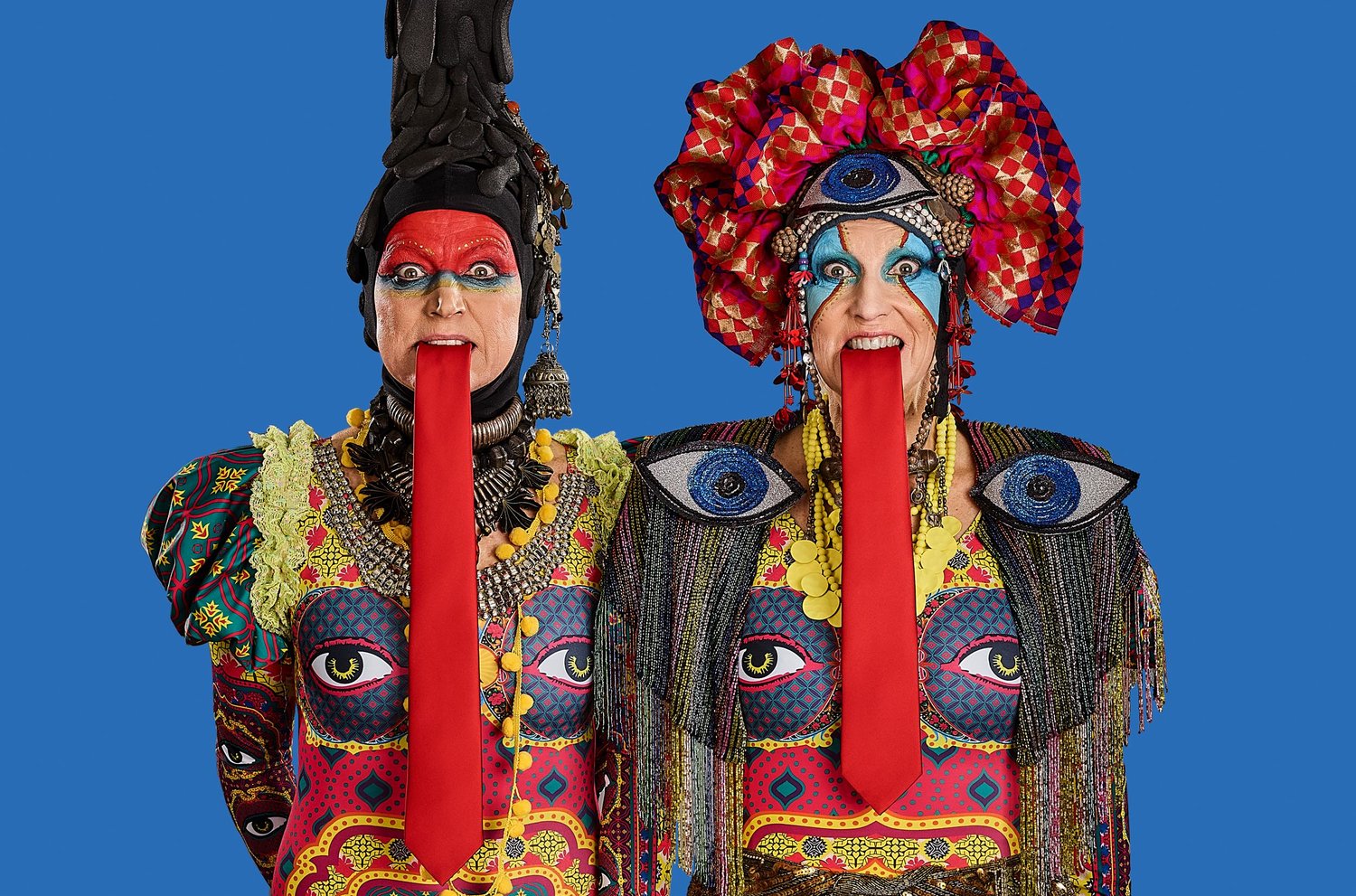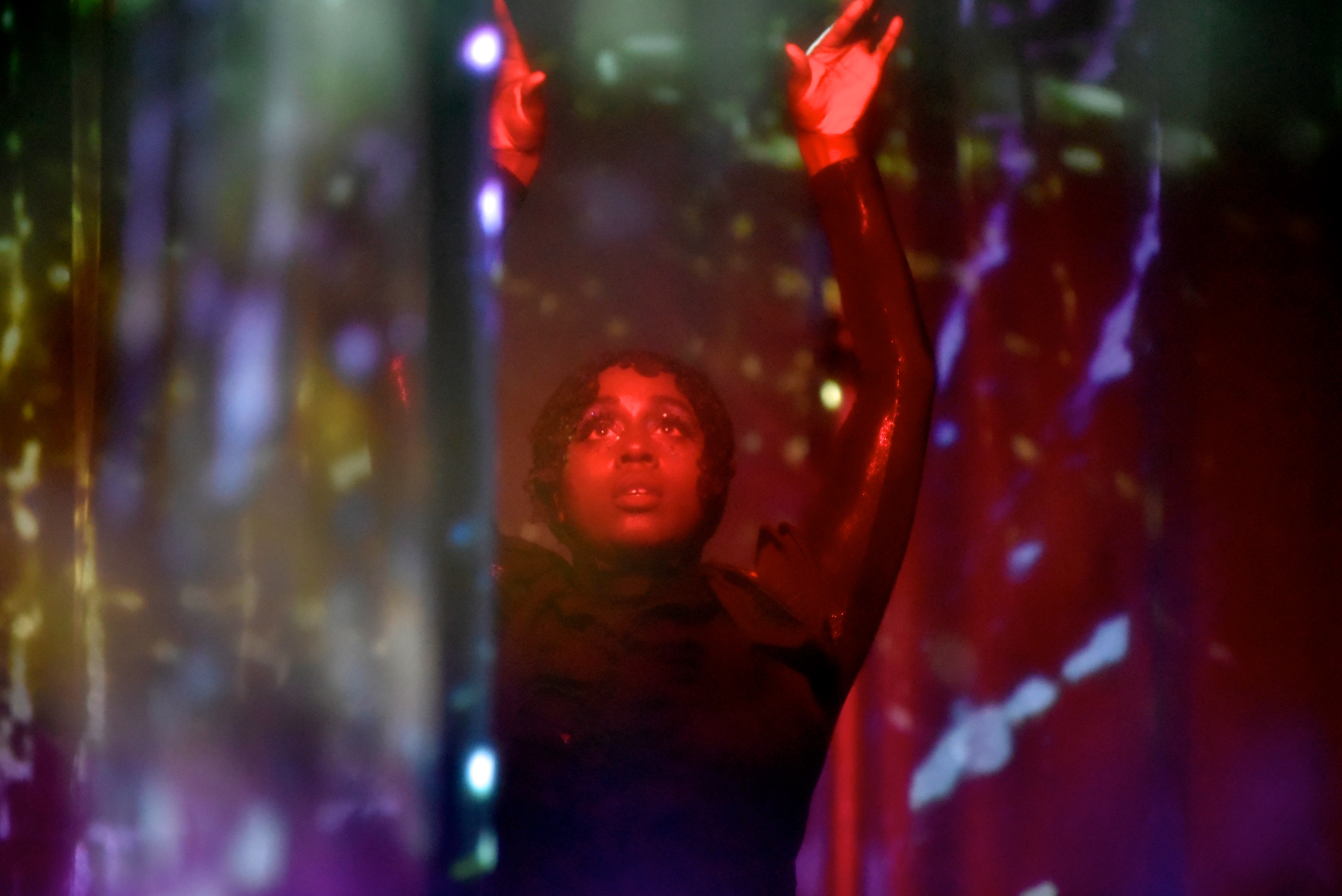‘You are entering an Afrofuturist, mythical landscape that explores what it’s like to see the world through someone else’s eyes.’
We are at Lighthouse, a film and multimedia centre specialising in ‘connecting new developments in art, technology, science and society’. It’s the first weekend of the Brighton Festival, and we’re here to mark the opening of Distorted Constellations, the new exhibition-installation by Nwando Ebizie. At the far end of this large, open-plan, ground-floor space is a bar, and a DJ station where Nwando is behind the decks (or behind her laptop, more precisely), resplendent in a pleated silver jumpsuit, enormous lashes, and a fabulously wild and woolly Afro – channelling her alter-ego, Lady Vendredi, I assume at the time – although I later learn that this particular alter-alter-ego is called Nwa-Kpa-Kpa-Ndo.
At the street end of the room there are sofas and a coffee table heaving with books. Titles include The Nature of Mind, Haitian Vodou – Spirit, Myth and Reality, Neuroscience – Exploring the Brain, Women Who Run with the Wolves, A Short History of Myth. There’s Maya Deren and at least two Angela Carters. I grab a glass of wine at the bar and settle down with Roberto Strongman’s Queering Black Atlantic Religions – Transcorporeality in Candomblé, Santeria and Vodou. Yeah I know – a bit of light reading for a Saturday night…
Actually, it’s far more of an accessible read than the title implies. I speed-read the introduction, which reflects on similarities in African diaspora or ‘creolised’ religious practices that have their origins in Nigeria or other parts of West Africa; transposed to Haiti (Vodou), Brazil (Candomblé), and Cuba and other Spanish speaking islands in the Caribbean (Santeria). I read about the role the Initiation Chamber plays in the rituals; and the importance of moving through levels, working from entrance space to ante chamber to the inner sanctum.
Although – as Nwando would be the first to say – what we encounter tonight is not a Vodou ritual, it honours those traditions, and builds on them to create a new, personal form of ritual as interactive performing arts practice. Nwando and her collaborators have created a sacred space in which, working through from ‘outer’ to ‘inner’ levels, a ritual is enacted to usher in her new installation work. Distorted Constellations explores ideas of perception and neuro-divergence – inspired by Nwando’s rare neurological disorder ‘visual snow’, which causes visual distortions such as flickering dots, auras and glowing lines. The main installation is sited in the downstairs gallery, but we are not ready yet to go there…
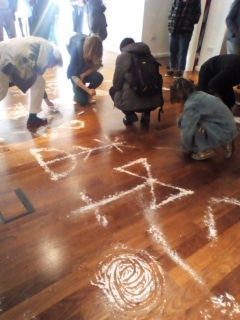
The Initiation Chamber
So, upstairs in this Initiation Chamber, we are invited to make a large circle, and are welcomed in by Nwando and her companions, two women dressed in white (the traditional colour for Vodou/Candomblé/Santeria initiates). One of these women is the guardian of the Sensory Ante Chamber – which we will get to in a while. The other is ritual practitioner and Haitian dancer Karine Label. A white circle is marked with what I take to be salt (although it could be powdered chalk) and Karine Label takes the space. Her movement work is elegant and engaging, referencing the healing practice of Vodou dance, which aims to draw together the elements of fire, earth air and water; and to provide a conduit for the ‘loa’ or lesser gods, thus uniting the physical and spiritual worlds. Karine’s dance, moving as it does through a cycle of gently flowing, undulating movements evoking the purification of water, then into energised fiery staccato and chaotic movements, reminds me that many contemporary ‘free dance’ practices such as 5 Rhythms and Chakradance owe a lot to traditional ritualistic dance. Nwando joins her in the circle, with the third woman, placed in the doorway to the Ante Chamber, supporting from afar in a three-way movement and voice call-and-response.
We are then invited to make our mark – drawing our responses, or reflecting on ideas and images conjured – using white chalk. The circle on the floor becomes a teeming canvas of symbols: simple arrows, stars, and triangles or more complex spirals, snowflakes and labyrinths.
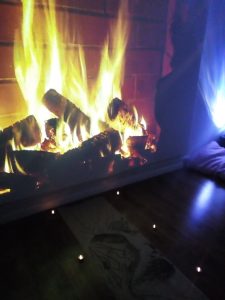
The Sensory Ante Chamber
There is now an open invitation to come into the Sensory Ante Chamber, its guardian stepping aside from the door with a welcoming smile. Inside, there are two spaces, one dedicated to fire and one to earth. Always intrigued by the lure of a hidden space behind a black curtain, I first go into the smaller room where I find tiny peat pots, compost and an assortment of seeds ready for planting and watering. In the ‘fire’ space, there is more opportunity for drawing: this time with charcoal, onto a brown paper ‘carpet’ that leads off from a whole-wall video of a raging fire. Tiny night-lights line the walkway, and in the corner is an egg: a tent that becomes the site for shadow theatre when bodies enter. Part of me is disappointed that there is no real fire – but once I’ve got over that, I end up sitting in this room for a long time, enjoying the flickering of the filmed fire, and listening to the audio installation of ambient music available through headphones propped up on big cushions in the corner. (Nwando is also the composer of the music and soundscapes used in the installations.)
Meanwhile, groups (we had all been issued with a coloured dot on arrival) are being called down to the main installation, in the room which is dubbed Install.
This downstairs gallery space sees a maze of panels dressed with white gauze. We are free to move through the paths between the semi-see-through walls, which become the site for projections, as do the white walls of the room. There is no attempt to disguise the architecture of the room, so speakers, switches, light fittings, and wooden doors are all visible through the gauze. Which I muse on for quite a while, and don’t reach a conclusion on. It is obviously a deliberate decision not to neutralise the space with white plasterboard walls or whatever galleries usually do, and I respect that, even though I find this defiance of the usual ‘white cube’ rules a little odd at first.
As we move through the space, we inevitably become part of the installation, casting shadows or becoming silhouetted figures viewed from outside of the labyrinth. The multi-layered projections animating the space are mostly monochrome. Sometimes the effect is the visual equivalent of white noise – a blur of fuzzy dots and lines, like the tuning-in static of an old TV set. Then, there are the more distinct, repetitive abstract patterns, with columns and rows of white dashes intersecting and interlacing. But there are also figurative images – a kind of deconstructed dancing figure appears in many places all at once, sometimes losing her edges, blurring out as if dissolving into her own aura, and at other times a clearly delineated reverse-silhouette image. The cultural values and associations of ‘black’ and ‘white’, ‘light’ and ‘shadow’, are there to reflect on. As the speed at which the projections shift and change increases, it becomes harder to distinguish between image seen and after-image perceived – one of the many clever plays on perception in the piece. Another is the Alice in Wonderland feeling, as you walk through the space, of pursuing an image that doesn’t seem to be there when you arrive. Sometimes you turn your head to be dazzled by a light or projection, causing a moment of sympathetic ‘white snow’ experience as white dazzle-dots appear in front of your eyes to echo the projected dots in the installation. What is inside and what is outside? The two merge after a while.
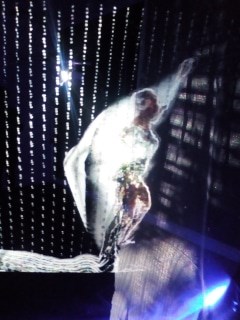
Distorted Constellations: Install
Back upstairs, we find the room arranged so that sofas and chairs face the DJ desk and screen above it. Then comes the only section of the evening I don’t enjoy – a lecture on the psychology of perception. The lecturer (a guest scientist whose name I didn’t catch) lacks performance presence – yes, she’s a scientist not an artist, but still! Her technology fails (there’s a kind of interactive online quiz that we are asked to engage with, but the link doesn’t work and she spends a lot of time obviously thrown and irked by this); and her tone is jolly GCSE teacher, as she (unnecessarily, surely? We’ve all been to school) explains the difference between rods and cones, and muses on those tired old visual perception conundrums (Is it a vase? Is it a face?). I struggle to understand why we have to sit through this.
A much better presentation follows, as Nwando treats us to some Autonomous Sensory Meridian Response (ASMR) inspired storytelling. We sit in dim light, and are asked to close our eyes. Nwando’s lovely voice, with her soft Brummy accent, tells us the tale of the Skeleton Woman, hauled from the bottom of the sea by a sailor, who takes her home to his bed. (The story is featured in Women Who Run with the Wolves, by Clarissa Pinkola Estés, and has become a feminist classic in recent years – a story of female empowerment, of love conquering fear and death, and of the merging of the male and female spirits in order to become whole.) As Nwando speaks, Karine moves through the space with scented water in a bowl and soft brushes, giving a moment of massage here, an anointment there.
After, follows the ritual feast: the serving of tapioca pancakes, a dish popular in the Caribbean and Brazil, which sadly has to be abandoned after a short while due to another technical failure, this time with the portable electric stove, which seems to be short-circuiting the system. Never mind, we’ll stick to crisps…
The evening ends joyously with a last dance, in which all, performers and audience, are invited into the circle to shake off or integrate (whatever way you want to view it) what we’ve absorbed over this long evening. There is much laughter and hugging before a parting of the ways.
A week later, I return to Lighthouse for Nwando’s 20 Minutes of Action which takes place within her Distorted Constellations installation. The music has been composed using analogue digital instruments/equipment. Nwando draws on a dance practice that has embraced Haitian Vodou, Vogueing, Ballet and Contemporary Dance. It’s a performance that balances opposites adroitly. At times, she is still for long periods, lying low in the installation to the sound of a low-level drone, another object in the space to be projected upon. In another moment, she is up and dancing with full energy, the music matching her physical action, making for a ritualistic and repetitive trance-dance that needs no audience. Then at other points, relationship with audience become paramount – she looks through the gauze at us, making eye contact, or seems to mirror the actions of the projected dancing figures to us. She draws on her interest in a contemporary feminist exploration of folklore (Clarissa Pinkola Estés, Angela Carter et al), and traditional African mythology to create archetypical images of womanhood: I see (or think I see) many voduns (orixás.): a proud and womanly mother-figure moving with slow steps through the space, a personification of night-time moonlight energy; a younger woman who shows off her own virility, beauty and sensuality in a series of Vogue poses; an earth-creature, drawn down to the ground with increasing heaviness; a light and lyrical air creature who spins and turns with child-like abandon.
After about fifteen minutes the monochrome images made of white light and shadow shift into a brightly coloured palette, and in its final five minutes, the installation-performance starts to resemble something from the heyday of psychedelia – Andy Warhol’s Exploding Plastic Inevitable, say. The colours are a shock – I can’t remember them from the week before. Did I experience them on that previous occasion? Could I have forgotten? Ah, memories, dreams, reflections! What do we really see? What do we think we’ve seen? What do we remember seeing?
Distorted Constellations – the installation and all the associated live actions and related activities – is a thoroughly satisfying experience. There are many artworks out there that pay lip-service to an investigation of the borderline between art and science – in this case, I feel that there has been a genuine engagement with the psychology of perception, and a truly interesting artistic investigation of a new scientific discovery. (‘Visual snow’ was only formerly identified as a syndrome in 2014.) We are invited not only to see the world through someone else’s (Nwando’s) eyes, and to imagine how a particular neuro-diversity alters perception; but also to question our own perceptions.
To see is to believe; but perhaps also, to believe is to see.
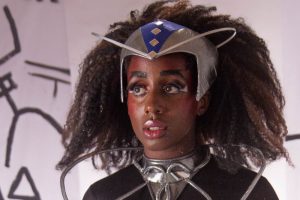
Nwando Ebizie
Featured image (top of page}: Nwando Ebizie: 20 Minutes of Action, Distorted Constellations at Lighthouse, 11 May 2019. Photo by Anya Arnold, courtesy of Lighthouse.
For more about Nwando Ebizie’s work see www.nwandoebizie.com
Distorted Constellations ran at Lighthouse 4–19 May 2019, co-presemted by Lighthouse and Brighton Festival
It was supported by Re-Imagine Europe, and co-funded by the Creative Europe project of the EU. The project also received support from Arts Council England.
Distorted Constellations comes from ideas developed originally with MAS productions, Nwando Ebizie working with director Jonathan Grieve, and supported by Arts Admin, Guest Projects and Wellcome Collection.
Movement elements of the piece were created with the support of choreographer and dramaturg Laura Kriefman. Digital Visuals Designer: Coral Manton.
The installation was accompanied by ritual performances, workshops and other activities, including: The Opening Ceremony, Saturday 4 May and 20 Minutes of Action, Saturday 11 May (both of which were attended by Dorothy Max Prior); a Haitian Ritual Dance workshop led by Karine Label; Intimacy/Touch/Tingles, Saturday 18 May; The World of Visual Snow (talk by neuroscientist Dr Francesca Puledda) plus The Closing Salon, also 18 May.

